Hydrangea Dentel de Gorron - features of care
Among domestic gardeners, the Dentel de Gorron hydrangea is very popular due to its abundant flowering, elegant appearance, unpretentious care and high winter hardiness. The variety was bred in 2013 by French breeders in the city of Gorron, from whose name it got its name.
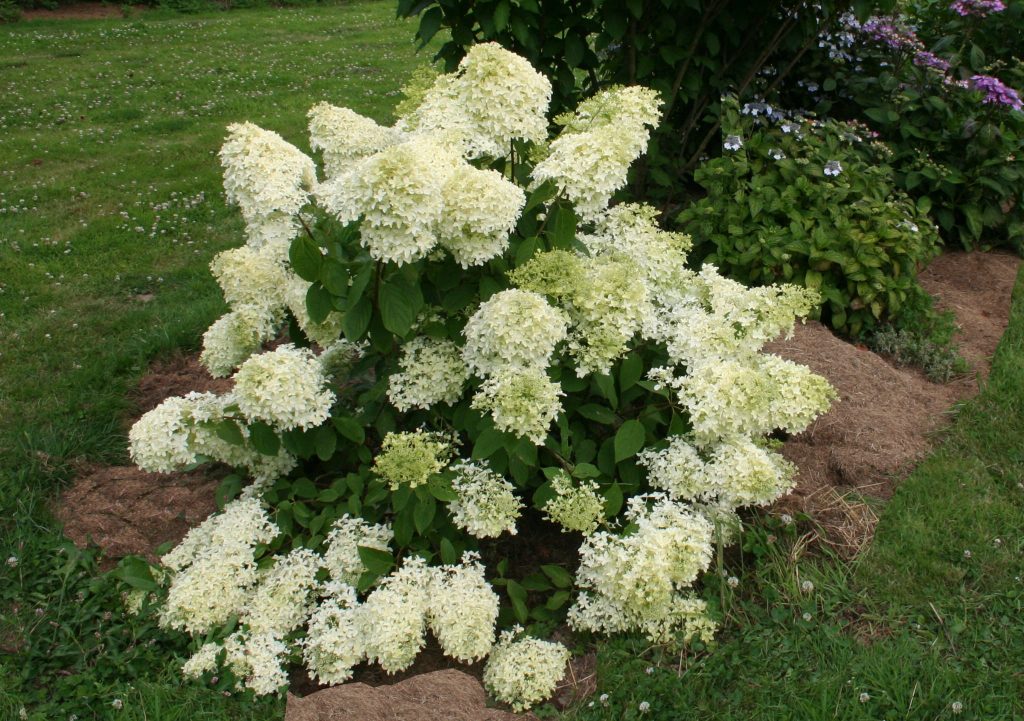
Hydrangea paniculata dentelle de gorron
Description of the variety
Dentel de Gorron belongs to the type of panicle hydrangea. The official name is Hydrangea paniculata Dentelle de Gorron Rencri.
The selection is based on wild plants brought by botanists from the Far East - China, Japan, Korea - the natural habitat of Hortensiaceae. Under natural conditions, the bush grows sprawling and very high - up to 4 m.
Scientists from the Renault nursery, located in the Goron town of the Mayenne department in western France, conjured over the appearance of the variety. Under the leadership of Jean Reno, they tried to refine its appearance, make the shape more compact, abundant flowering, while maintaining high frost resistance down to -29 ° C.
External data
The shrub has a rounded, compact and highly branched shape. Its average height in temperate latitudes is 1.5-2 m, and its width is 2 m in adulthood. In warm countries, on rich soils, it grows up to 2.5 m or more. The leaves are large, pointed, bright green, matte. They retain their color from the beginning of the growing season to the end of summer. In autumn they turn yellow, giving the garden a delicate color. The growth rate is moderate.
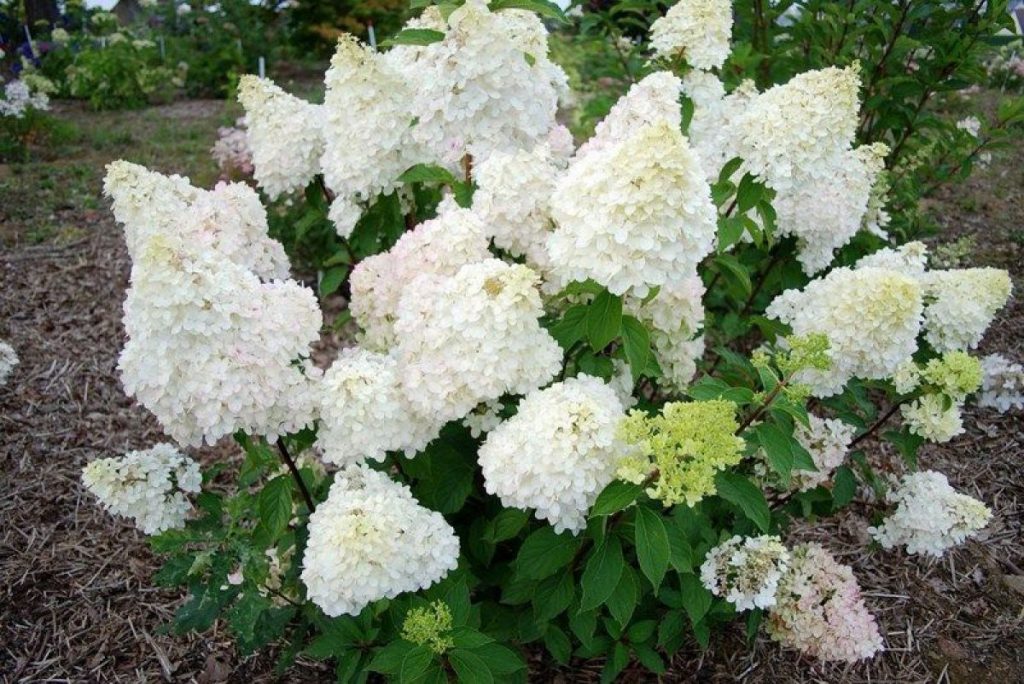
Hydrangea dentel de gorron
The main wealth of the Dentel de Gorron variety is the numerous (up to fifty) cone-shaped paniculate inflorescences resembling a cloud. They are very large, reaching 30-35 cm when grown outdoors. The shape of the panicles is light, delicate, airy.
It is no coincidence that Dentelle de Gorron translates as “Goron's lace”. The effect appears due to long pedicels at the base of the inflorescence, symmetrically decreasing towards its apex.
The flowers themselves are also interesting. At the beginning of flowering, they are light green or cream, but as they mature, they brighten, eventually becoming snow-white.
At the same time, they bloom unevenly, therefore, greenish, creamy and white shades can contrast on one panicle.
The flowers are mostly sterile, simple, small, but numerous. The petals are thin, smooth, boat-shaped, with smooth edges. Grouped by 4 pieces. Fertile flowers are few - no more than 25%.
Paniculata hydrangea is distinguished by early flowering periods. To the south, the first flowers bloom in mid-June, to the north - by the end of the month. The season lasts until September inclusive.
Landing features
Hydrangea paniculata is an unpretentious plant. It will grow anywhere in the garden. But in order for the flower to grow healthy and show the best decorative qualities, it is recommended to choose acidic soil for planting, slightly moistened, drained and well fertilized.

Hydrangea dentelle de gorron
Rooted cuttings can be planted at any time of the year.
It is better to transplant an adult bush in the spring, at the beginning of the growing season. Over the summer, he adapts to a new place and will survive the winter better.
Seat selection
For planting, it is advisable to choose a bright, but slightly shaded area from the direct sun at midday. For example, next to a fence, nearby bushes or tall flowers.
Loam is preferred among all soil types.
The soil must be dug up, fertilized and loosening elements must be added, but not sand. Especially for hydrangeas, there is an option to prepare a soil mixture from earth, compost and peat.
Peat may not be the best solution, especially in rainy years. It can be replaced with deciduous soil, vermiculite, perlite, a mixture of straw and finely chopped twigs.
Seedling preparation
For planting, choose strong seedlings with an even juicy color of foliage, without suspicious spots, plaque, deformation of shoots.
Pale leaves and sluggish young shoots indicate either poor care from the owners or the seller, or the disease of the specimen. In the first case, hydrangea on good soil and with regular watering will quickly heal, in the second, it will infect neighboring flowers and trees, once it gets to the site. It's not worth the risk.
It is advisable to disinfect the seedling before planting. The roots can be placed in a container with a weak solution of potassium permanganate. And spray the green mass for prophylaxis with a complex fungicide.
Landing technology
- They dig a large hole (50 × 50 cm and 60-70 cm deep).
- At the bottom, drainage must be equipped with a layer of 10-20 cm. The materials at hand are suitable: expanded clay, ceramic shards, broken brick or slate, gravel or pebbles.
- If the soil is poor, organic fertilizer is poured on top: 1 bucket of manure that has exceeded 2-3 years, or 1-2 buckets of matured compost.
- Part of the pit is sprinkled with earth so that the lower roots of the bush touch it when planting. The seedling is placed in a hole and the root system is added dropwise to the middle.
- Spill the well with water. Under its streams, the earth will fill the inevitable microvoids. The soil will settle a little - this is normal.
- Finally, the hole is filled up to the root collar of the bush. Tamp down slightly. Water the hole well again and fill up the earth if necessary.
The cuttings are planted in the same way, with the exception of manipulating the root system. A large hole is needed to lay the drainage. The stalk will eventually grow into a large bush, and in the absence of drainage underground, it can get sick from stagnant water and die.
How to care
Paniculate hydrangeas are perhaps the most hardy of all subspecies. They are not demanding to care for. They have a record frost resistance for the family. But some rules for growing must still be adhered to.
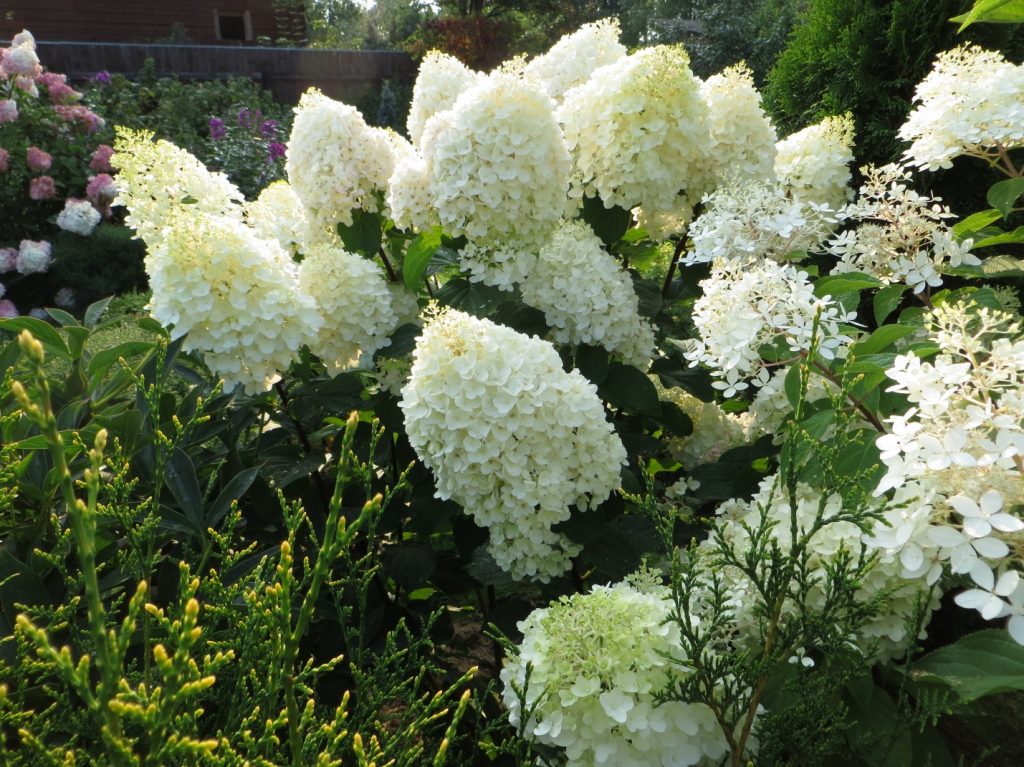
Hydrangea dentel de gorron paniculata
Watering
You should not be zealous with watering, otherwise the plant can be infected with fungal infections.
- Young seedlings (1-2 years old) are regularly watered at the rate of 10 liters per bush.
- Adult hydrangea bushes are watered once every 1-2 weeks in the absence of rain for a long time.
Top dressing
They are important on medium to poor soils, as well as for shrubs that have been growing in one place for many years, even if the land around is fertile.
The first feeding is carried out at the beginning of the growing season. Better in liquid form - so minerals are absorbed faster. Gardeners recommend using a complex solution of superphosphate fertilizers and potassium sulfate. After that, the hole is sprinkled with mulch and / or compost - an additional source of organic matter.
The second time the bush is fed during the period of bud growth. Preference is given to nitrogenous fertilizers, which include magnesium, iron, minerals. From July to September, monthly infusion of mullein is fed.
Attention! It is impossible to bring ash into the ground for feeding. It lowers the acidity of the soil, which slows down the development of the plant.
Pruning
It is carried out for abundant flowering with the formation of large panicles, the formation of a beautiful silhouette with a lush crown and the rejuvenation of old specimens. It is better to cut it in early spring, along the thawed patches.Peduncles are formed on the shoots of the current year.

Hydrangea dentel de gorron reviews
First of all, thin stems are removed. This also applies to zero shoots growing from the bottom of the roots. Then the branches growing inside the bush are cut. Next, the skeletal large stems are cut into 2-3 buds. Strong flower stalks will form at this place. Frost-damaged branches are also removed.
Faded, dried inflorescences on young bushes break off in the fall, so that under the weight of snow they do not deform thin branches. On old specimens with stiff stems, many gardeners leave panicles until spring: they are decorative and serve as additional heat protection.
Attention! Hydrangea bushes are pruned before the buds have awakened.
Preparing for winter
It consists in mulching the soil under the bush. Any material will do: straw, hay, sawdust, leaves, compost, needles.
A number of gardeners completely cover the hydrangeas with either a covering material, or they make crates / boxes from slats or wire, which are covered with fallen leaves or straw.
Reproduction
Hydrangea is propagated by cuttings. Thus, it retains varietal qualities for several generations to come. For this:
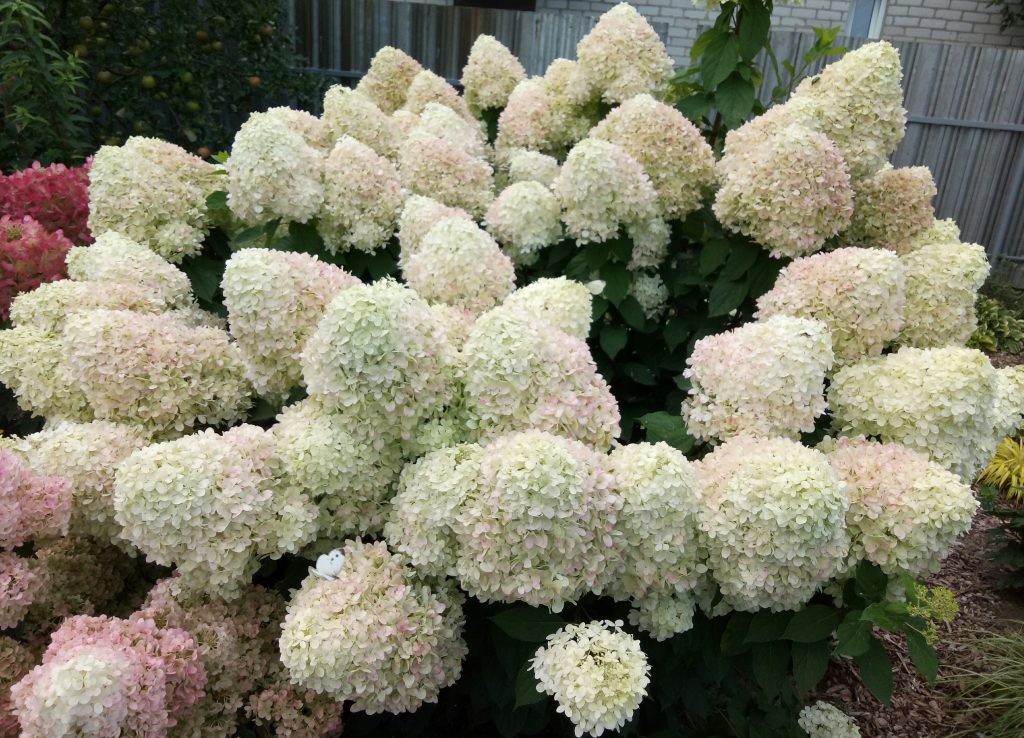
Hydrangea paniculata hydrangea paniculata dentelle de gorron
- Choose a healthy shoot with at least 3 pairs of leaves, but preferably four.
- Cut it off from above at a distance of 10-20 cm from the crown.
- 1-2 pairs of leaves are cut off from below - roots will grow from their sinuses. In this case, at least 2 pairs of leaves should remain on top.
- Cuttings of hydrangea paniculata root perfectly in moist soil, so it makes no sense to put them in water for a long time, waiting for the roots to appear. Before planting in the soil mixture, it is desirable to place the lower part in a solution of "Kornevin" or a similar root formation stimulator for 2-3 hours.
- Cuttings adapt faster and take root in a humid, warm environment. To do this, a mini-greenhouse is erected above them, or a jar, a plastic bottle is placed. To prevent the remaining leaves from rotting from contact with the wet walls of the greenhouse, their ends are cut off.
- If planting was carried out in flower pots or tubs, they must be removed from the bright sun in partial shade. If planted in the garden in a permanent place, equip a shelter from the sun (if required).
- After 2-3 weeks, the roots will be strong enough.
Diseases and pests
The panicle hydrangea Dentel de Gorron has many natural enemies. Let's consider the main problems in the table.
| Disease | Cause | How to determine | ||
| Root rot | Appears with prolonged waterlogging of the soil. | The plant is withering away | You can try to transplant the bush to a more sunny, elevated place, simultaneously cutting off the affected areas of the root system. Complex fungicides are used for treatment: "Glyokladin", "Discor", "Maxim". Among the new generation drugs, Previkur Energy stands out. It not only fights fungal manifestations, but stimulates root growth. | To avoid decay of the underground part of the plant, drainage must be done before planting. Do not pour water over the hydrangea. In the spring, feed with immunomodulatory agents. |
| Chlorosis | A typical disease for hydrangeas of all subspecies (the formation of chlorophylls is disrupted in the green mass, which in turn reduces photosynthesis). | Yellowing, general lightening of leaves. | When the soil is depleted, or its acidity changes, the plant is fed with fertilizers containing nitrogen, magnesium, iron. With bacterial chlorosis, the bush is destroyed. | They carry out regular feeding on poor soils. Also, do not water with hard or unsettled cold water. This leads to alkalization of the mail, and hydrangea loves an acidic environment. |
| Gray rot | Frequent companion of wet weather | Plant rot | Affected leaves and stems are burned, the bush is treated with Fundazol. To prevent the fungus from flourishing, thin out the plantings in time, remove debris, dried branches. | Do not plant hydrangeas in the shade near other tall plants or a damp corner of the plot, especially under slopes of roofs from which streams of rain flow down. |
| Powdery mildew | A fungal disease that often manifests itself in the fall. | With a large area of damage, the plant inhibits | It is treated with an extensive list of fungicides. For example, "Skorom", "Topaz", "Fitosporin-B" | For prevention, provide an influx of fresh air and sunlight. Do not be zealous with watering. |
| Downy mildew | A consequence of the cool wet summer. | White bloom on the leaves. | To combat, use a solution of copper sulfate (15 g) and laundry soap (1 pack) for 10 liters of water. Among modern less toxic drugs are biofungicides "Gamair", "Alirin-B", "Fitosporin". | In the spring, you can feed the hydrangea with microbiological fertilizer and growth stimulator "Baikal EM-1". |
Landscape use
Dentel de Gorron is a universal variety. The well-known flower company Sapho, which oversees its distribution, recommends the flower for creating green borders and joint plantings with other perennials, as well as an excellent specimen (solo, single planting). In the latter case, it looks the most striking.
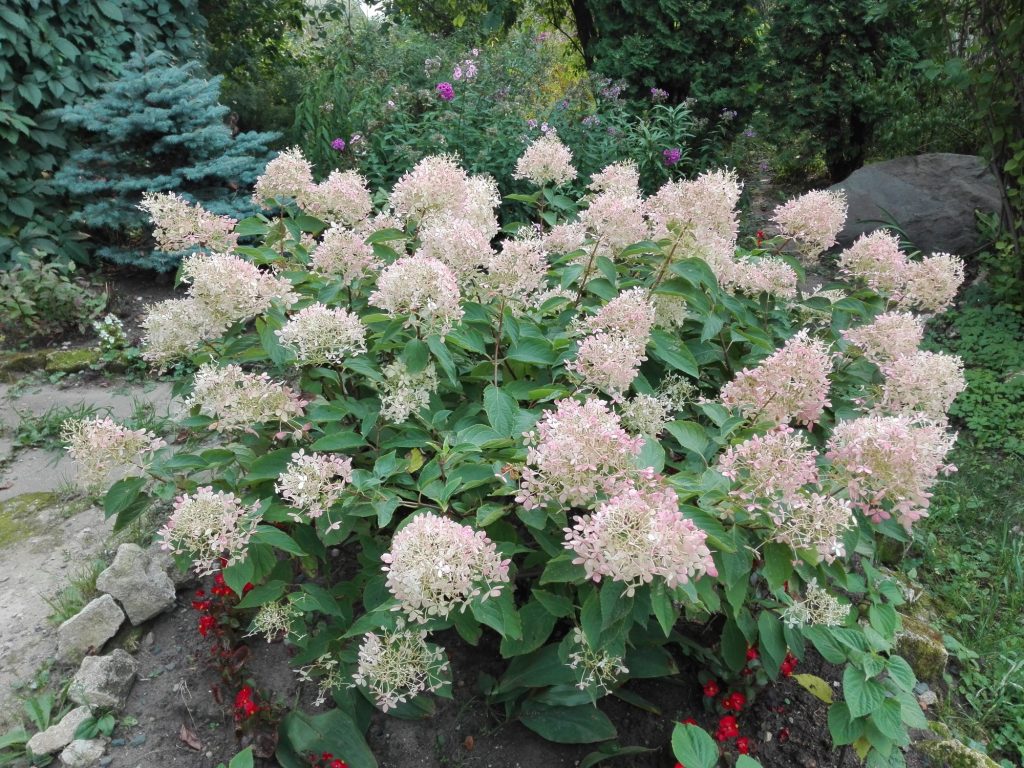
Hydrangea paniculata dentelle de gorron
Hydrangea goes well with hosts, phlox, astilba, anemone, mountain goats, miscanthus, varieties of excellent color.
Growing large plants in tubs is popular in Europe - in this case, the owners can change the location of the hydrangea, experimenting with landscape design.
Indoor cultivation of Dentelle de Gorron is practiced. A more compact bush is formed in flower pots, the size of the inflorescences decreases. The charm of the plant does not disappear anywhere.
Testimonials
The variety has only recently appeared on the domestic market. In Europe, it is respected and considered one of the best among white panicle hydrangeas. People are impressed by the neat shape of the bush, large lace inflorescences, disease resistance and high resistance to cold weather. There are no frankly weak sides.

